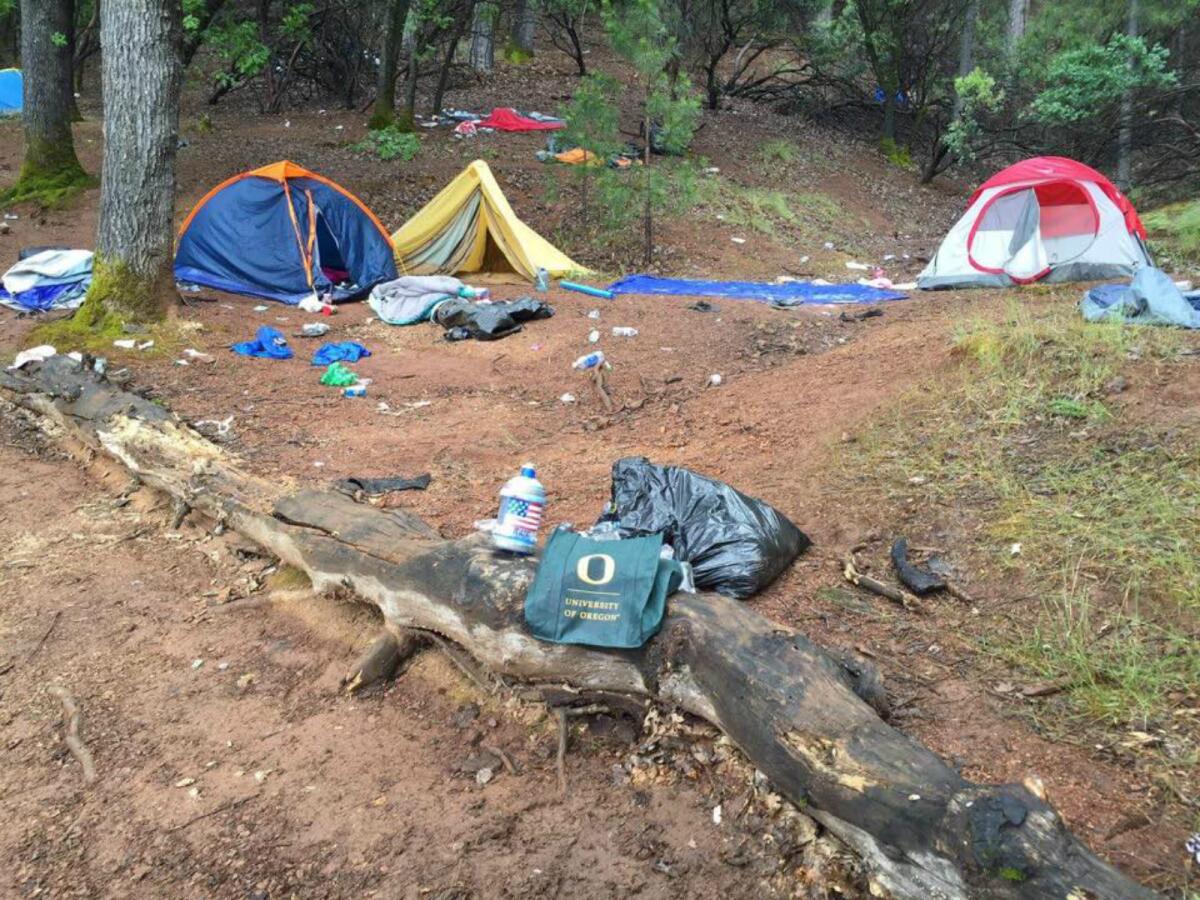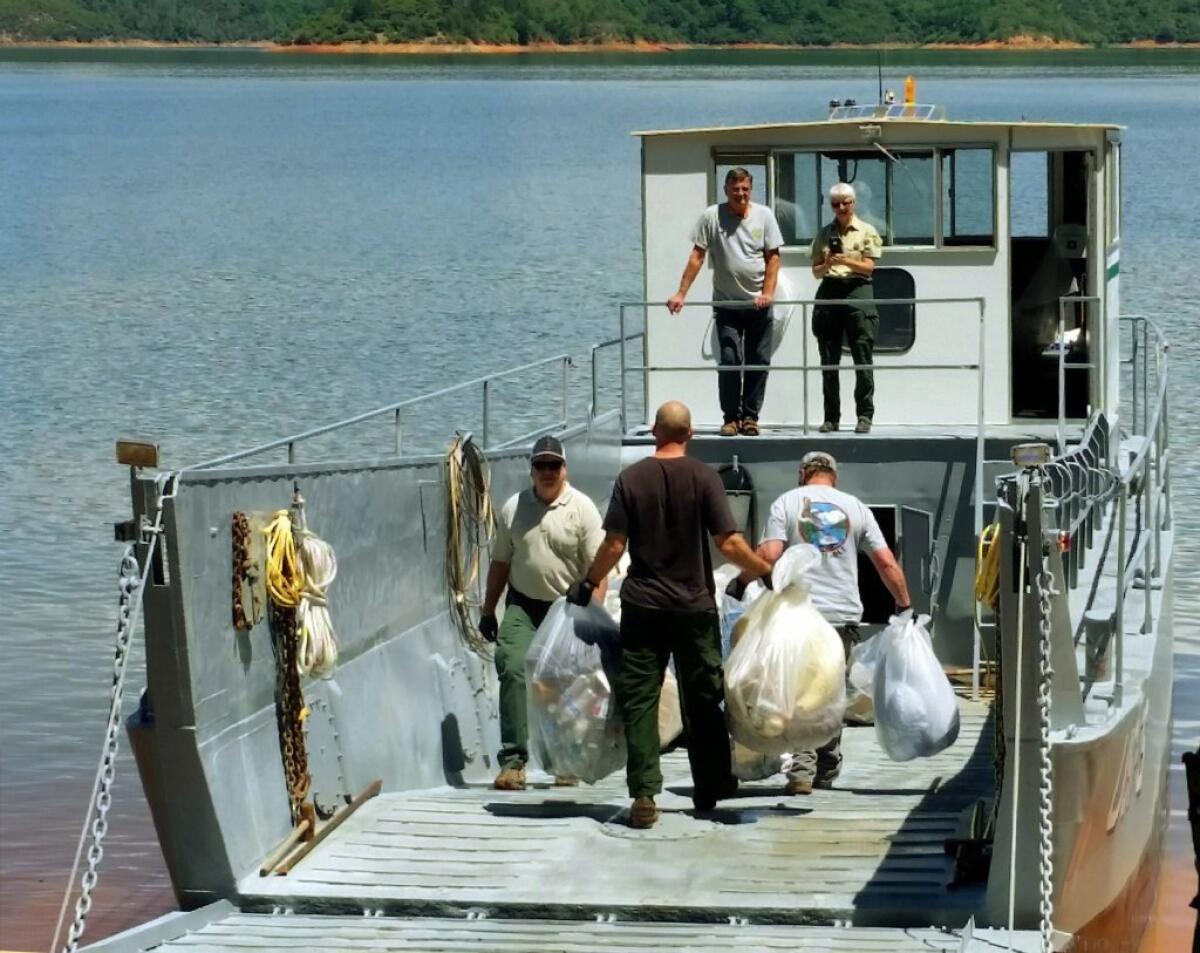After ‘disgraceful’ trashing of Shasta Lake last year, Oregon college students clean up their act

- Share via
The scene at Shasta Lake this Mother’s Day weekend was dramatically different from last year, when members of a University of Oregon fraternity were accused of leaving piles of litter, feces, beer bottles and tents at a campsite.
The detritus of last year’s lake trip sparked outrage among residents, university officials and the U.S. Forest Service after photographs of the trashed lakeside went viral. At the time, Robin Holmes, the university's vice president for student life, called the actions “disgraceful” and Lambda Chi Alpha’s activities were suspended.
This year’s lake trip, however, was different, officials said.
Activity at the lake was subdued, possibly because there were fewer students visiting, according to Deputy Ray Hughes, a spokesman for the Shasta County Sheriff’s Office’s boating safety unit. About 65 houseboats were docked at Slaughterhouse Island.
The amount of trash left behind by Oregon college students was also “drastically reduced” during the May 13-14 weekend, he said in a statement. The U.S. Forest Service worked with the students to shrink the amount of waste accumulated during their annual trek to the lake, the deputy said in a statement.
Carol Underhill, a spokeswoman for the Shasta-Trinity National Forest, said this year, there was one-tenth of the trash of last year, when rangers had to use a large-sized patrol boat to remove garbage. This time, rangers were able to use a normal-sized boat.
Emergency calls at the lake also dropped from 300, the average amount of calls over Mother’s Day weekend, to 50, she said.
“It was a much quieter scene overall,” Underhill said.
‘It was almost like aliens came down and sucked them out from where they were’
After every annual lake visit, which usually occurs on Mother’s Day weekend, rangers typically find party-type trash, U.S. Forest Service spokeswoman Phyllis Swanson said last year.

But after the May 21-22 weekend last year, authorities found more than party trash.
Rangers discovered sleeping bags, nearly 100 tents, clothing, designer sandals, boxes of beer cans, chairs, unopened packages of food and ice chests, including one cooler painted with the name of the fraternity and the words "Do you wanna do some blow man?"
“It was almost like aliens came down and sucked them out from where they were,” Swanson said at the time. “Things were just found where they were last seen. I mean shoes were left behind.”
Some 1,000 students had descended on Slaughterhouse Island and left a half-mile-radius campground, she said.
About 25 Forest Service employees removed up to 30 yards of trash, including condoms, tampons and lots of human feces, Swanson said.

‘These trips are not a recognized … event’
Weeks ahead of the annual visit, park officials started the #KeepShastaClean social media campaign and rangers worked with university administrators to limit destruction of the lake.
Officials from the University of Oregon and
“While these trips are not a recognized or sponsored event by either university, we do know students make their own choice to participate,” the letter said. “Our biggest concerns regarding these student weekends is for student safety and well-being. We also are mindful of student activities resulting in negative environmental impacts as has been the case in the past.”
Students were provided with information on using situational awareness and being safe and responsible. Residents were also urged to call the university with any concerns.
Letters were also sent to sororities and fraternities, urging them to discourage students from “participating in high-risk behavior and understand the potential serious consequences of a visit to Lake Shasta.” The university warned that students may still be held accountable for their actions.
“Over the last year, the University of Oregon and Oregon State University have been working on a collaborative approach to address the behavior that occurred at Lake Shasta in spring 2016,” the university wrote. “Unfortunately, in recent history, each of our institutions have experienced the death of students and severe injury as well as other dangerous and disruptive behavior associated with travel to Lake Shasta.”
The lake has served as a getaway for college students since the 1990s. It has also been the scene of tragedies.
In 2005, a student committed suicide while visiting the lake. Other students have drowned during the trip or suffered serious injuries.
‘Large volumes of litter’ and hacked trees left behind
About 70 miles south in Chico, university officials are dealing with similar problems. There, a Chico State University fraternity has come under fire after a state wildlife refuge in Tehama County was trashed last month.
According to the Tehama County Sheriff’s Office, deputies received a report on April 28 that a group of college-aged adults was camping in a remote and unimproved campsite at the refuge on California 32 near Deer Creek Trail. Campers left “large volumes of litter,” had cut down trees and were trespassing into closed areas of the refuge, the Sheriff’s Office said.
Photographs of the vandalism showed piles of pallet boards, trash and tree stumps strewn across the campsite.
JD Elam told KRCR-TV he was camping nearby when he was greeted by students who introduced themselves as members of a Chico State fraternity. The men told him they were pledging the fraternity and participating in an initiation ceremony.
The fraternity named has denied any involvement, saying it has filed a police report regarding the person making the allegations.
In a statement posted on the fraternity’s Facebook account, members said: “Additionally, we are cooperating with authorities in their investigation. We have concerns for the safety of our members after receiving threats against [the] chapter following this accusation and have notified the local police regarding these threats.”
The university said it was investigating the claims to determine who was responsible for the vandalism.
“Meanwhile, we want to say unequivocally that regardless of who perpetrated the vandalism, the act in and of itself is completely unacceptable,” the university said in an campus-wide email. “As members of the Chico community, we believe an affront like this is an affront to us all. If any of our students were involved in this unfortunate incident, we will ensure they are held accountable."
Now the U.S. Forest Service is investigating. They recently asked for help in identifying seven men seen at a home improvement store purchasing items used in the vandalism.

Sign up for Essential California
The most important California stories and recommendations in your inbox every morning.
You may occasionally receive promotional content from the Los Angeles Times.







